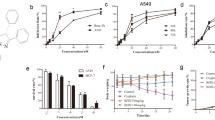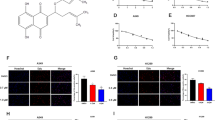Abstract
Wnt/β-catenin signaling plays important role in cancers. Compound 759 is one of the compounds previously screened to identify inhibitors of the Wnt/β-catenin pathway in A549 cells [Lee et al. in Bioorg Med Chem Lett 20:5900–5904, 2010]. However, the mechanism by which Compound 759 induces the inhibition of the Wnt/β-catenin pathway remains unknown. In our study, we employed various assays to comprehensively evaluate the effects of Compound 759 on lung cancer cells. Our results demonstrated that Compound 759 significantly suppressed cell proliferation and Wnt3a-induced Topflash activity and arrested the cell cycle at the G1 stage. Changes in Wnt/β-catenin signaling-related protein expression, gene activity, and protein stability including Axin, and p21, were achieved through western blot and qRT-PCR analysis. Compound 759 treatment upregulated the mRNA level of p21 and increased Axin protein levels without altering the mRNA expression in A549 cells. Co-treatment of Wnt3a and varying doses of Compound 759 dose-dependently increased the amounts of Axin1 in the cytosol and inhibited β-catenin translocation into the nucleus. Moreover, Compound 759 reduced tumor size and weight in the A549 cell-induced tumor growth in the in vivo tumor xenograft mouse model. Our findings indicate that Compound 759 exhibits potential anti-cancer activity by inhibiting the Wnt/β-catenin signaling pathway through the increase of Axin1 protein stability.







Similar content being viewed by others
Data availability
The datasets analyzed and displayed during this research are available from the corresponding authors upon reasonable request.
References
Lee SB, Park YI, Dong MS, Gong YD. Identification of 2,3,6-trisubstituted quinoxaline derivatives as a Wnt2/beta-catenin pathway inhibitor in non-small-cell lung cancer cell lines. Bioorg Med Chem Lett. 2010;20(19):5900–4. https://doi.org/10.1016/j.bmcl.2010.07.088.
Guimaraes PPG, Tan M, Tammela T, Wu K, Chung A, Oberli M, Wang K, Spektor R, Riley RS, Viana CTR, Jacks T, Langer R, Mitchell MJ. Potent in vivo lung cancer Wnt signaling inhibition via cyclodextrin-LGK974 inclusion complexes. J Control Release. 2018;290:75–87. https://doi.org/10.1016/j.jconrel.2018.09.025.
Lu Y, Zhang X, Zhang H, Zhu Z. Prognosis and biological function of miR-3195 in non-small cell lung cancer. Cancer Manag Res. 2022;14:169–76. https://doi.org/10.2147/CMAR.S345618.
Sette G, Salvati V, Giordani I, Pilozzi E, Quacquarini D, Duranti E, De Nicola F, Pallocca M, Fanciulli M, Falchi M, Pallini R, De Maria R, Eramo A. Conditionally reprogrammed cells (CRC) methodology does not allow the in vitro expansion of patient-derived primary and metastatic lung cancer cells. Int J Cancer. 2018;143(1):88–99. https://doi.org/10.1002/ijc.31260.
Bosch-Barrera J, Verdura S, Ruffinelli JC, Carcereny E, Sais E, Cuyas E, Palmero R, Lopez-Bonet E, Hernandez-Martinez A, Oliveras G, Buxo M, Izquierdo A, Moran T, Nadal E, Menendez JA. Silibinin suppresses tumor cell-intrinsic resistance to Nintedanib and enhances its clinical activity in lung cancer. Cancers (Basel). 2021. https://doi.org/10.3390/cancers13164168.
Hiremath IS, Goel A, Warrier S, Kumar AP, Sethi G, Garg M. The multidimensional role of the Wnt/beta-catenin signaling pathway in human malignancies. J Cell Physiol. 2022;237(1):199–238. https://doi.org/10.1002/jcp.30561.
Zeng H, Lu B, Zamponi R, Yang Z, Wetzel K, Loureiro J, Mohammadi S, Beibel M, Bergling S, Reece-Hoyes J, Russ C, Roma G, Tchorz JS, Capodieci P, Cong F. mTORC1 signaling suppresses Wnt/beta-catenin signaling through DVL-dependent regulation of Wnt receptor FZD level. Proc Natl Acad Sci USA. 2018;115(44):E10362–9. https://doi.org/10.1073/pnas.1808575115.
MacDonald BT, Tamai K, He X. Wnt/beta-catenin signaling: components, mechanisms, and diseases. Dev Cell. 2009;17(1):9–26. https://doi.org/10.1016/j.devcel.2009.06.016.
MacDonald BT, He X. Frizzled and LRP5/6 receptors for Wnt/beta-catenin signaling. Cold Spring Harb Perspect Biol. 2012. https://doi.org/10.1101/cshperspect.a007880.
Jeong W, Jho EH. Regulation of the low-density lipoprotein receptor-related protein LRP6 and its association with disease: Wnt/beta-catenin signaling and beyond. Front Cell Dev Biol. 2021;9:714330. https://doi.org/10.3389/fcell.2021.714330.
Clevers H, Loh KM, Nusse R. Stem cell signalling. An integral program for tissue renewal and regeneration: Wnt signaling and stem cell control. Science. 2014;346(6205):1248012. https://doi.org/10.1126/science.1248012.
Jung YS, Park JI. Wnt signaling in cancer: therapeutic targeting of Wnt signaling beyond beta-catenin and the destruction complex. Exp Mol Med. 2020;52(2):183–91. https://doi.org/10.1038/s12276-020-0380-6.
Gillespie J, Ross RL, Corinaldesi C, Esteves F, Derrett-Smith E, McDermott MF, Doody GM, Denton CP, Emery P, Del Galdo F. Transforming growth factor beta activation primes canonical Wnt signaling through down-regulation of Axin-2. Arthritis Rheumatol. 2018;70(6):932–42. https://doi.org/10.1002/art.40437.
Zhan T, Rindtorff N, Boutros M. Wnt signaling in cancer. Oncogene. 2017;36(11):1461–73. https://doi.org/10.1038/onc.2016.304.
Melnik S, Dvornikov D, Muller-Decker K, Depner S, Stannek P, Meister M, Warth A, Thomas M, Muley T, Risch A, Plass C, Klingmuller U, Niehrs C, Glinka A. Cancer cell specific inhibition of Wnt/beta-catenin signaling by forced intracellular acidification. Cell Discov. 2018;4:37. https://doi.org/10.1038/s41421-018-0033-2.
Kim JH, Park SY, Jun Y, Kim JY, Nam JS. Roles of Wnt target genes in the journey of cancer stem cells. Int J Mol Sci. 2017. https://doi.org/10.3390/ijms18081604.
Li TM, Ren J, Husmann D, Coan JP, Gozani O, Chua KF. Multivalent tumor suppressor adenomatous polyposis coli promotes Axin biomolecular condensate formation and efficient beta-catenin degradation. Sci Rep. 2020;10(1):17425. https://doi.org/10.1038/s41598-020-74080-2.
Lee SB, Gong YD, Park YI, Dong MS. 2,3,6-Trisubstituted quinoxaline derivative, a small molecule inhibitor of the Wnt/beta-catenin signaling pathway, suppresses cell proliferation and enhances radiosensitivity in A549/Wnt2 cells. Biochem Biophys Res Commun. 2013;431(4):746–52. https://doi.org/10.1016/j.bbrc.2013.01.038.
Or CR, Huang CW, Chang CC, Lai YC, Chen YJ, Chang CC. Obatoclax, a Pan-BCL-2 inhibitor, downregulates survivin to induce apoptosis in human colorectal carcinoma cells via suppressing WNT/beta-catenin signaling. Int J Mol Sci. 2020. https://doi.org/10.3390/ijms21051773.
Gartel AL, Radhakrishnan SK. Lost in transcription: p21 repression, mechanisms, and consequences. Cancer Res. 2005;65(10):3980–5. https://doi.org/10.1158/0008-5472.CAN-04-3995.
Engeland K. Cell cycle regulation: p53–p21-RB signaling. Cell Death Differ. 2022;29(5):946–60. https://doi.org/10.1038/s41418-022-00988-z.
Ennis HL, Lubin M. Cycloheximide: aspects of inhibition of protein synthesis in mammalian cells. Science. 1964;146(3650):1474–6. https://doi.org/10.1126/science.146.3650.1474.
Yu F, Yu C, Li F, Zuo Y, Wang Y, Yao L, Wu C, Wang C, Ye L. Wnt/beta-catenin signaling in cancers and targeted therapies. Signal Transduct Target Ther. 2021;6(1):307. https://doi.org/10.1038/s41392-021-00701-5.
Neiheisel A, Kaur M, Ma N, Havard P, Shenoy AK. Wnt pathway modulators in cancer therapeutics: an update on completed and ongoing clinical trials. Int J Cancer. 2022;150(5):727–40. https://doi.org/10.1002/ijc.33811.
Gavagan M, Fagnan E, Speltz EB, Zalatan JG. The Scaffold protein Axin promotes signaling specificity within the Wnt pathway by suppressing competing kinase reactions. Cell Syst. 2020;10(6):515–525515. https://doi.org/10.1016/j.cels.2020.05.002.
Cha B, Kim W, Kim YK, Hwang BN, Park SY, Yoon JW, Park WS, Cho JW, Bedford MT, Jho EH. Methylation by protein arginine methyltransferase 1 increases stability of Axin, a negative regulator of Wnt signaling. Oncogene. 2011;30(20):2379–89. https://doi.org/10.1038/onc.2010.610.
Kim S, Jho EH. The protein stability of Axin, a negative regulator of Wnt signaling, is regulated by Smad ubiquitination regulatory factor 2 (Smurf2). J Biol Chem. 2010;285(47):36420–6. https://doi.org/10.1074/jbc.M110.137471.
Huang SM, Mishina YM, Liu S, Cheung A, Stegmeier F, Michaud GA, Charlat O, Wiellette E, Zhang Y, Wiessner S, Hild M, Shi X, Wilson CJ, Mickanin C, Myer V, Fazal A, Tomlinson R, Serluca F, Shao W, Cheng H, Shultz M, Rau C, Schirle M, Schlegl J, Ghidelli S, Fawell S, Lu C, Curtis D, Kirschner MW, Lengauer C, Finan PM, Tallarico JA, Bouwmeester T, Porter JA, Bauer A, Cong F. Tankyrase inhibition stabilizes axin and antagonizes Wnt signalling. Nature. 2009;461(7264):614–20. https://doi.org/10.1038/nature08356.
Koirala S, Klein J, Zheng Y, Glenn NO, Eisemann T, Fon Tacer K, Miller DJ, Kulak O, Lu M, Finkelstein DB, Neale G, Tillman H, Vogel P, Strand DW, Lum L, Brautigam CA, Pascal JM, Clements WK, Potts PR. Tissue-specific regulation of the Wnt/beta-catenin pathway by PAGE4 inhibition of Tankyrase. Cell Rep. 2020;32(3):107922. https://doi.org/10.1016/j.celrep.2020.107922.
Piperdi B, Ling YH, Liebes L, Muggia F, Perez-Soler R. Bortezomib: understanding the mechanism of action. Mol Cancer Ther. 2011;10(11):2029–30. https://doi.org/10.1158/1535-7163.MCT-11-0745.
Lui TT, Lacroix C, Ahmed SM, Goldenberg SJ, Leach CA, Daulat AM, Angers S. The ubiquitin-specific protease USP34 regulates axin stability and Wnt/beta-catenin signaling. Mol Cell Biol. 2011;31(10):2053–65. https://doi.org/10.1128/MCB.01094-10.
Lehtio L, Chi NW, Krauss S. Tankyrases as drug targets. FEBS J. 2013;280(15):3576–93. https://doi.org/10.1111/febs.12320.
Thorvaldsen TE, Pedersen NM, Wenzel EM, Stenmark H. Differential roles of AXIN1 and AXIN2 in Tankyrase inhibitor-induced formation of degradasomes and beta-catenin degradation. PLoS ONE. 2017;12(1):e0170508. https://doi.org/10.1371/journal.pone.0170508.
Tolwinski NS, Wieschaus E. Rethinking WNT signaling. Trends Genet. 2004;20(4):177–81. https://doi.org/10.1016/j.tig.2004.02.003.
Cong F, Varmus H. Nuclear-cytoplasmic shuttling of Axin regulates subcellular localization of beta-catenin. Proc Natl Acad Sci USA. 2004;101(9):2882–7. https://doi.org/10.1073/pnas.0307344101.
Jamieson C, Sharma M, Henderson BR. Targeting the beta-catenin nuclear transport pathway in cancer. Semin Cancer Biol. 2014;27:20–9. https://doi.org/10.1016/j.semcancer.2014.04.012.
Vadlakonda L, Pasupuleti M, Pallu R. Role of PI3K-AKT-mTOR and Wnt signaling pathways in transition of G1-S phase of cell cycle in cancer cells. Front Oncol. 2013;3:85. https://doi.org/10.3389/fonc.2013.00085.
Habib SJ, Acebron SP. Wnt signalling in cell division: from mechanisms to tissue engineering. Trends Cell Biol. 2022;32(12):1035–48. https://doi.org/10.1016/j.tcb.2022.05.006.
Liu Q, Ran R, Song M, Li X, Wu Z, Dai G, Xia R. LncRNA HCP5 acts as a miR-128-3p sponge to promote the progression of multiple myeloma through activating Wnt/beta-catenin/cyclin D1 signaling via PLAGL2. Cell Biol Toxicol. 2022;38(6):979–93. https://doi.org/10.1007/s10565-021-09628-7.
Liu LH, Shi RJ, Chen ZC. Paeonol exerts anti-tumor activity against colorectal cancer cells by inducing G0/G1 phase arrest and cell apoptosis via inhibiting the Wnt/beta-catenin signaling pathway. Int J Mol Med. 2020;46(2):675–84. https://doi.org/10.3892/ijmm.2020.4629.
Xiao ZD, Han L, Lee H, Zhuang L, Zhang Y, Baddour J, Nagrath D, Wood CG, Gu J, Wu X, Liang H, Gan B. Energy stress-induced lncRNA FILNC1 represses c-Myc-mediated energy metabolism and inhibits renal tumor development. Nat Commun. 2017;8(1):783. https://doi.org/10.1038/s41467-017-00902-z.
Ma HM, Cui N, Zheng PS. HOXA5 inhibits the proliferation and neoplasia of cervical cancer cells via downregulating the activity of the Wnt/beta-catenin pathway and transactivating TP53. Cell Death Dis. 2020;11(6):420. https://doi.org/10.1038/s41419-020-2629-3.
Harper JW, Adami GR, Wei N, Keyomarsi K, Elledge SJ. The p21 Cdk-interacting protein Cip1 is a potent inhibitor of G1 cyclin-dependent kinases. Cell. 1993;75(4):805–16. https://doi.org/10.1016/0092-8674(93)90499-g.
Goh KY, Ng NW, Hagen T, Inoue T. p21-activated kinase interacts with Wnt signaling to regulate tissue polarity and gene expression. Proc Natl Acad Sci U S A. 2012;109(39):15853–8. https://doi.org/10.1073/pnas.1120795109.
Peng X, Lai KS, She P, Kang J, Wang T, Li G, Zhou Y, Sun J, Jin D, Xu X, Liao L, Liu J, Lee E, Poss KD, Zhong TP. Induction of Wnt signaling antagonists and p21-activated kinase enhances cardiomyocyte proliferation during zebrafish heart regeneration. J Mol Cell Biol. 2021;13(1):41–58. https://doi.org/10.1093/jmcb/mjaa046.
Strzeszewska-Potyrala A, Staniak K, Czarnecka-Herok J, Rafiee MR, Herok M, Mosieniak G, Krijgsveld J, Sikora E. Chromatin-directed proteomics identifies ZNF84 as a p53-independent regulator of p21 in genotoxic stress response. Cancers (Basel). 2021. https://doi.org/10.3390/cancers13092115.
Raghu D, Karunagaran D. Plumbagin downregulates Wnt signaling independent of p53 in human colorectal cancer cells. J Nat Prod. 2014;77(5):1130–4. https://doi.org/10.1021/np4010085.
Takagaki N, Sowa Y, Oki T, Nakanishi R, Yogosawa S, Sakai T. Apigenin induces cell cycle arrest and p21/WAF1 expression in a p53-independent pathway. Int J Oncol. 2005;26(1):185–9.
Acknowledgements
This study was supported by a grant from the National Research Foundation of Korea (NRF) funded by the Korean Government (NRF-2018R1A2B6008860).
Funding
This study was supported by a grant from the National Research Foundation of Korea (NRF) funded by the Korean Government (NRF-2018R1A2B6008860).
Author information
Authors and Affiliations
Contributions
SS: performed biological experiments and wrote the main manuscript text. JSK prepared Fig. 7. YDG provided Compound 759. MSD provided research funding. MSD and YC are SS advisors and directed the research as co-corresponding authors.
Corresponding author
Ethics declarations
Conflict of interest
The authors declare that they have no competing interests.
Ethical approval
Animal experiments were conducted in accordance with the guidelines and approval of the Institutional Animal Care and Use Committee of the Korea Research Institute of Bioscience and Biotechnology (Approval #: KRIBB-AEC-12024).
Additional information
Publisher's Note
Springer Nature remains neutral with regard to jurisdictional claims in published maps and institutional affiliations.
Supplementary Information
Below is the link to the electronic supplementary material.
Rights and permissions
Springer Nature or its licensor (e.g. a society or other partner) holds exclusive rights to this article under a publishing agreement with the author(s) or other rightsholder(s); author self-archiving of the accepted manuscript version of this article is solely governed by the terms of such publishing agreement and applicable law.
About this article
Cite this article
Sun, S., Gong, YD., Kang, J.S. et al. A small molecule compound 759 inhibits the wnt/beta-catenin signaling pathway via increasing the Axin protein stability. Med Oncol 41, 147 (2024). https://doi.org/10.1007/s12032-024-02314-8
Received:
Accepted:
Published:
DOI: https://doi.org/10.1007/s12032-024-02314-8




